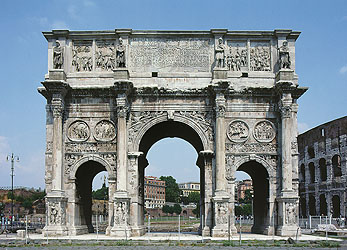
The emperor said that about the noon hour, when the day was already beginning to wane, he saw with his own eyes in the sky above the sun a cross composed of light, and that there was attached to it an inscription saying, "By this conquer." At the sight, he said, astonishment seized him and all the troops who were accompanying him on the journey and were observers of the miracle. He said, moreover, that he doubted within himself what the import of this apparition could be, And while he continued to ponder and reason on its meaning, night suddenly came on; then in his sleep, the Christ of God appeared to him with the same sign which he had seen in the heavens, and commanded him to make a likeness of that sign which he had seen in the heavens, and to use it as a safeguard in all engagements with his enemies. At dawn of day, he arose, and communicated the marvel to his friends; and, then, calling together the workers in gold and precious stones, he sat in the midst of them, and described to them the figure of the sign he had seen, bidding them represent it in gold and precious stones.-- Eusebius, Life of Constantine, I, chapters 28-30. |
On October 28, 312, while preparing for the Battle of the Milvian Bridge against his rival Maxentius, Constantine, according to his biographer Eusebius, saw the sign of Christ in the heavens. What to the modern reader has the ring of a constructed fiction to the Late Antique and Medieval world was a fundamental reality. Just as God had called Moses to lead the Israelites to the Promised Land, God had intervened in human history to insure Constantine's victory at the Milvian Bridge. This was a central moment in western history. Before that moment, Christianity had been an outlawed religion in the Roman world. As an acknowledgement of divine aid at the Battle of the Milvian Bridge, Constantine, in 313, issued the Edict of Milan which granted toleration for Christianity. Constantine became imperial patron for Christianity. Although Christianity would not become the official religion of Rome until later in the fourth century, Christianity and Rome would never be the same after the time of Constantine.
To commemorate Constantine's victory at the Battle of the Milvian Bridge and to celebrate his decennalia (July 25, 315), the Senate granted the privilege to build a Triumphal Arch in the center of Rome. In doing this, the Senate was following a custom that extended back to the Republican period, when Rome was controlled by the Senate. Triumphal Arches commemorated triumphs, civil ceremonies in Rome that celebrated victories by the Roman military. The Senate granted a special decree to allow the commander to enter Rome with his army. Constantine's arch would be seen in close physical proximity to earlier arches like those dedicated to 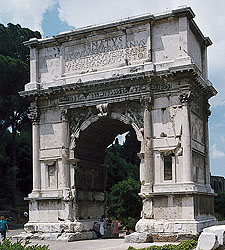 Titus and Septimius Severus. Its size and triple bay format outdid these earlier arches. The following formal inscription is repeated in the center of both sides of the attic:
Titus and Septimius Severus. Its size and triple bay format outdid these earlier arches. The following formal inscription is repeated in the center of both sides of the attic:
| IMP · CAES · FL · CONSTANTINO · MAXIMO · P · F · AVGUSTO · S · P · Q · R · QVOD · INSTINCTV · DIVINITATIS · MENTIS · MAGNITVDINE · CVM · EXERCITV · SVO · TAM · DE · TYRANNO · QVAM · DE · OMNI · EIVS · FACTIONE · VNO · TEMPORE · IVSTIS · REM-PVBLICAM · VLTVS · EST · ARMIS · ARCVM · TRIVMPHIS · INSIGNEM · DICAVIT |
| To the Emperor Caesar Flavius Constantinus, the greatest, pious, and blessed Augustus, the Senate and People of Rome have dedicated this arch decorated with triumphs because with divine inspiration and the magnitude of his mind with his army and with just arms he has transformed the Republic from the tyrant and all of his factions at one time. |
Much of the inscription is consistent with the regular formulas of Roman culture. Constantine is identified as Emperor, Casesar, greatest, pious, and blessed Augustus, all traditional formulas. The dedication by the Senate and people of Rome (SPQR) conforms to the regular custom. The characterization of the defeat of Maxentius as the saving of the Republic from a tyrant appealed to an ongoing concern of Romans of their liberty being usurped by a tyrant. A striking aspect of this inscription and the Arch in general is the absence of direct references to Christianity. The inscription refers to "divine inspiration" (instinctu divinitatis). While this could be a veiled reference to the vision before the battle, this could be a reference to Constantine's adoption of the cult of "Sol Invictus" or the "invincible sun", early in his career. As characteristic of emperors under the Dominate, Constantine asserted his divine election. In the coin below, Constantine pairs his profile image on the obverse with the image of the Invincible Sun on the reverse. Instead of the traditional inscriptions like "To the Genius of the Roman People", Constantine's coin bears the inscription "To the Invincible Sun my companion." The power of Constantine comes from a divine source, and he becomes the companion of divinity. The cult of "Sol Invictus", which had become popular with Emperors during the later third century, reflected a trend towards monotheism with Sol being "one universal Godhead" who was "recognized under a thousand names." Monotheism was understood as an effective tool for consolidating power under a single ruler who received divine election.
The absence of explicit references to Christianity on his arch can be explained by the delicate political and cultural balancing act Constantine made between his appeal to the traditions of Imperial Rome and his interests in his adopted religion. The city of Rome was still dominated by an entrenched Senatorial class which had as one of its dominant values pietas or the respect of the traditional customs of Rome. The arch's inscription calls attention to Constantine's piety. Later in the fourth century this appeal to past customs was well voiced by Symmachus, a member of a Roman senatorial family, in his debate with Ambrose, the Bishop of Milan, over the continued presence of the Altar of Victory in the Roman Senate. The buildings associated with Constantine in Rome reflect this split between traditional Rome and his support for Christianity. This is documented in the accompanying Google map. The Constantinian buildings in the center of Rome (see purple markers) are more traditional with no explicit Christian associations. These include the Basilica, Baths, and the Arch. These buildings were built in the vicinity of the great Imperial monuments (see blue markers). The Arch of Constantine (see green marker) was built adjacent to the Coloseum. This siting of his Imperial buildings was clearly intended to link Constantine to the tradition of Roman Imperial power. While the Christian churches associated with Constantine's reign (see red markers) are found on the outskirts of Rome, principally outside the city walls. The one exception to this is the church of St. John the Lateran, but this was built on land appropriated by Constantine after the defeat of Maxentius. The church which was established as the seat of the bishop of Rome was built adjoining the Sessorian Palace, Constantine's principal Roman residence.
Significantly it was decided to include on the Arch of Constantine reliefs that were taken from monuments made for earlier Emperors. There are reliefs in the passageway under the primary arch that are from the time of the Emperor Trajan, while the roundels or medallions were made for the Emperor Hadrian. The oblong reliefs in the attic come from the time of the Emperor Marcus Aurelius. The standing figures flanking the Aurelian reliefs in the attic were from the time of Trajan. Scholars used to argue that this use of "spolia" from earlier buildings was a good indication of artistic decline. More recently scholars have seen this inclusion of earlier monuments as a way of linking Constantine to the great emperors of the past. Trajan, Hadrian, and Marcus Aurelius were three of the greatest Roman emperors of the second century when Rome was at his fullest glory. The heads of the emperors on these earlier reliefs were recut to represent Constantine. So the original image of Trajan defeating the Dacians in the passageway relief became Constantine defeating Maxentius.
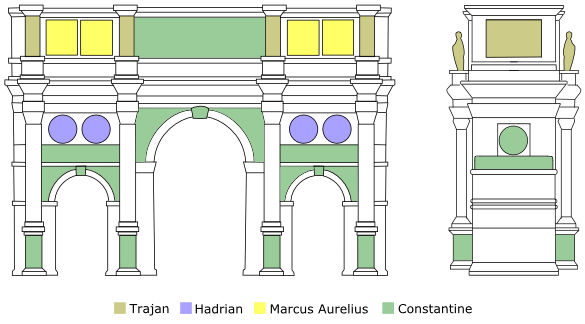
in Rome:

This connection between Constantine and Rome's past glory is also found in the Constantinian reliefs. For example, one of the principal Constantinian reliefs shows Constantine making an oration as part of the triumphal celebration after his defeat of Maxentius. The oration is set at the Rostra in the Roman Forum, the central public meeting place in Rome.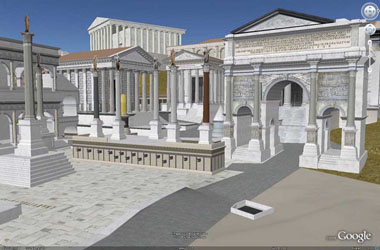
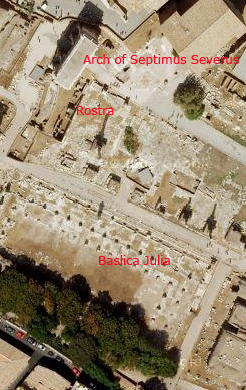 The arches on the right undoubtedly refer to the Arch of Septimius Severus while the structure on the left probably represents the Basilica Julia, begun by Julius Caesar in 46 Bce and completed by Augustus. The now beheaded figure of Constantine is shown in the center of the relief making the ad locutio gesture and wearing military dress. The origin of the office of imperator was as military commander. Constantine's dress and gesture thus define him as the voice of imperial authority. He is surrounded by frontal figures dressed in togas, the traditional dress associated with members of the senatorial class. At either end of the Rostra appear two seated figures elevated above the other figures. These seated figures are identifiable as sculptural portraits of Hadrian and Marcus Aurelius. The three highest figures in the relief are, thus, Constantine (had his head survived) and the two second century predecessors. The five columns behind the Rostra make a reference to the link between Constantine and his immediate predecessor Diocletian. In 303 A.D. a monument commemorating the tenth year of Diocletian's rule was constructed at the Rostra. The monument was composed of five columns with the central one topped by an image of Jupiter, flanked by others topped by images of the four Tetrarchs. This relief thus places Constantine at the center of Rome both physically, socially, and historically.
The arches on the right undoubtedly refer to the Arch of Septimius Severus while the structure on the left probably represents the Basilica Julia, begun by Julius Caesar in 46 Bce and completed by Augustus. The now beheaded figure of Constantine is shown in the center of the relief making the ad locutio gesture and wearing military dress. The origin of the office of imperator was as military commander. Constantine's dress and gesture thus define him as the voice of imperial authority. He is surrounded by frontal figures dressed in togas, the traditional dress associated with members of the senatorial class. At either end of the Rostra appear two seated figures elevated above the other figures. These seated figures are identifiable as sculptural portraits of Hadrian and Marcus Aurelius. The three highest figures in the relief are, thus, Constantine (had his head survived) and the two second century predecessors. The five columns behind the Rostra make a reference to the link between Constantine and his immediate predecessor Diocletian. In 303 A.D. a monument commemorating the tenth year of Diocletian's rule was constructed at the Rostra. The monument was composed of five columns with the central one topped by an image of Jupiter, flanked by others topped by images of the four Tetrarchs. This relief thus places Constantine at the center of Rome both physically, socially, and historically.
In your journal, compare the styles of these two reliefs.
On another face of the Arch we see medallions representing Hadrian participating in a Lion Hunt and him sacrificing juxtaposed to a frieze representing the largesse of Constantine:
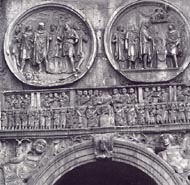
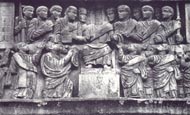
The image of Constantine's largesse reflects another standard formula of Roman Imperial Iconography. One of the attic reliefs from the time of Marcus Aurelius represents the "liberalitas" or largesse of this second century emperor:
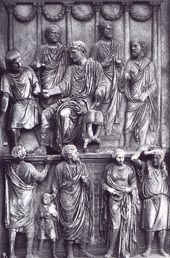
Significantly the head of Marcus Aurelius in this relief has been recut to represent Constantine. As exemplified by this head from one of the Hadrianic Medallions, other heads of the second century reliefs were recarved to represent Constantine:
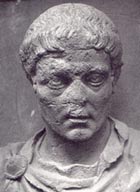
The carving of this head demonstrates the point that there were still sculptors available at the time of Constantine who were capable of working in the Classical style.
Despite this clear linking of Constantine to the Roman Imperial past, one can not help but be struck by the dramatic constrast in style between the earlier reliefs and the Constantinian reliefs:
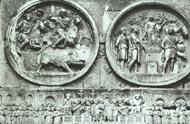
The medallions depict on the left Hadrian hunting and on the right Hadrian sacrificing at an altar dedicated to the god Apollo. The relief below shows in the center the beheaded figure of Constantine making an oration for the Rostrum
Imperial images ranged from monumental works like the over 8' head of Constantine that was part of a colossal statue of him in his Basilica in Rome:
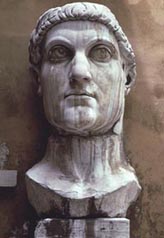
To imperial images on Roman coinage:
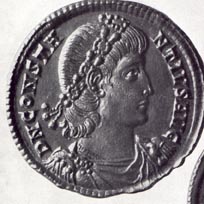
|
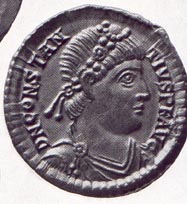
|
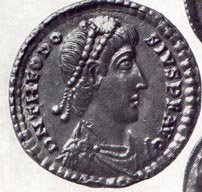
|
What do you make of the comparison of these different images? Compare these heads to that of the Colossus of Barletta. Write your responses in your journal.
A significant innovation / renovation in the portraiture of Constantine is the decision to represent himself beardless. From the second century emperors like Hadrian, it had been a regular convention to represent the emperor with a beard. This was apparently to relate the Emperor to conventions of representations of Greek Philosophers. The beardless type consciously adopted by Constantine links him back to the beardless formula adopted by Augustus and his successors (see the Augustus of Primaporta above). It thus signifies a break from the immediate past and a link to the foundation of Imperial rule with Augustus. The adoption of this formula by his successors was a way of establishing a dynastic link to Constantine as the new Augustus. It is significant that Julian the Apostate (reigned 361-3) who was the only pagan fourth century emperor revived the bearded type.